Project Management: Near Term Activities and Cost Estimates
VerifiedAdded on 2020/03/01
|5
|1282
|96
Report
AI Summary
This report delves into crucial aspects of project management, emphasizing the importance of focusing on near-term activities and activities with large cost estimates. It explains why project managers should prioritize these areas to facilitate efficient resource allocation, timely corrective actions, and effective budget management, ultimately preventing project delays and failures. The report highlights the significance of planning skills, the use of cost variance analysis, and the need to address negative cost variances by focusing on activities planned for the near term and those with substantial cost implications. It provides insights into the formula for cost variance, emphasizing how it indicates cost performance and the importance of timely corrective actions to maintain budget adherence. Furthermore, the report underscores the benefits of reducing costs through efficient resource allocation, material substitution, and the assignment of experienced personnel. The analysis underscores the importance of proactive project management for achieving project success and client satisfaction.
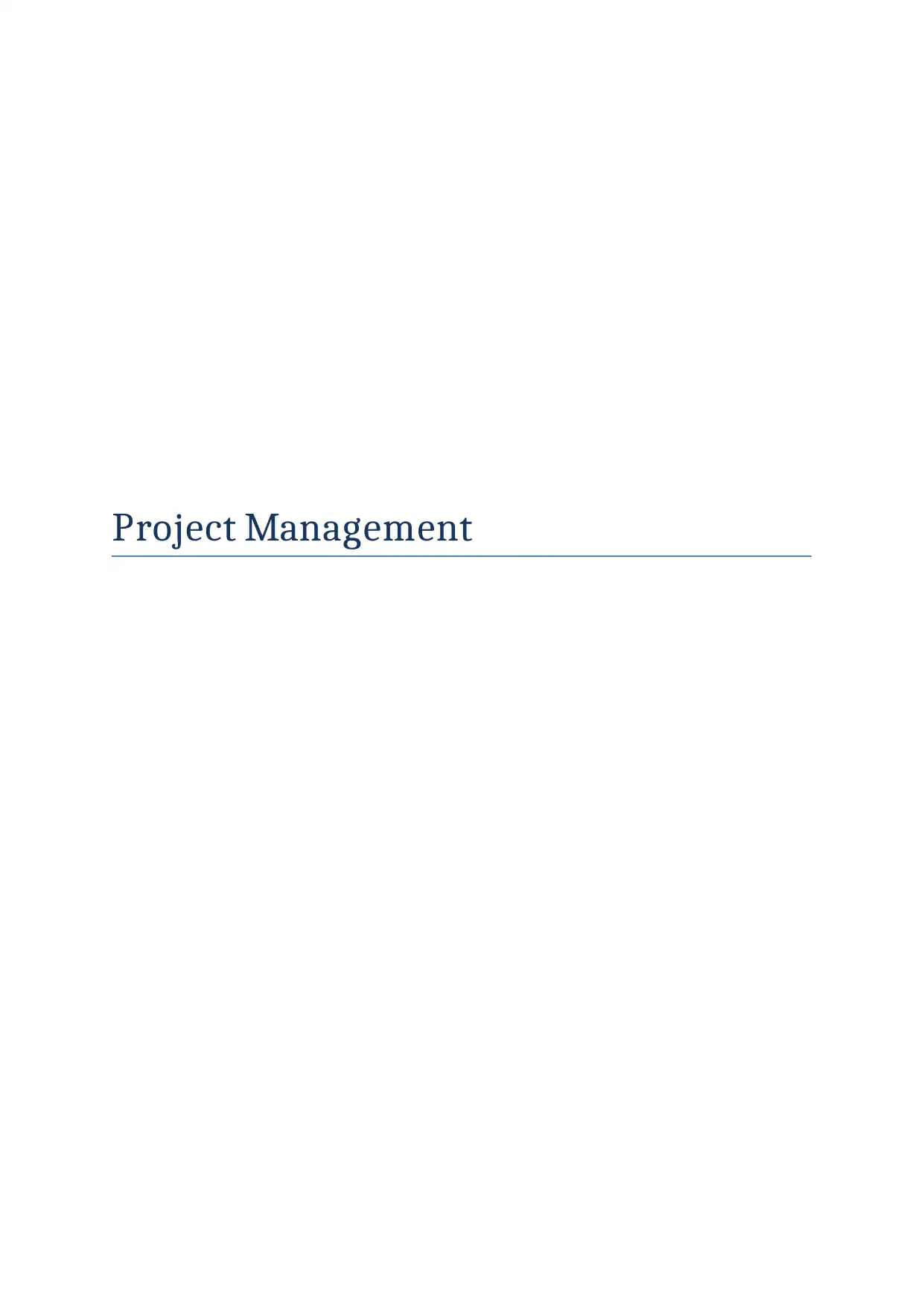
Project Management
Paraphrase This Document
Need a fresh take? Get an instant paraphrase of this document with our AI Paraphraser
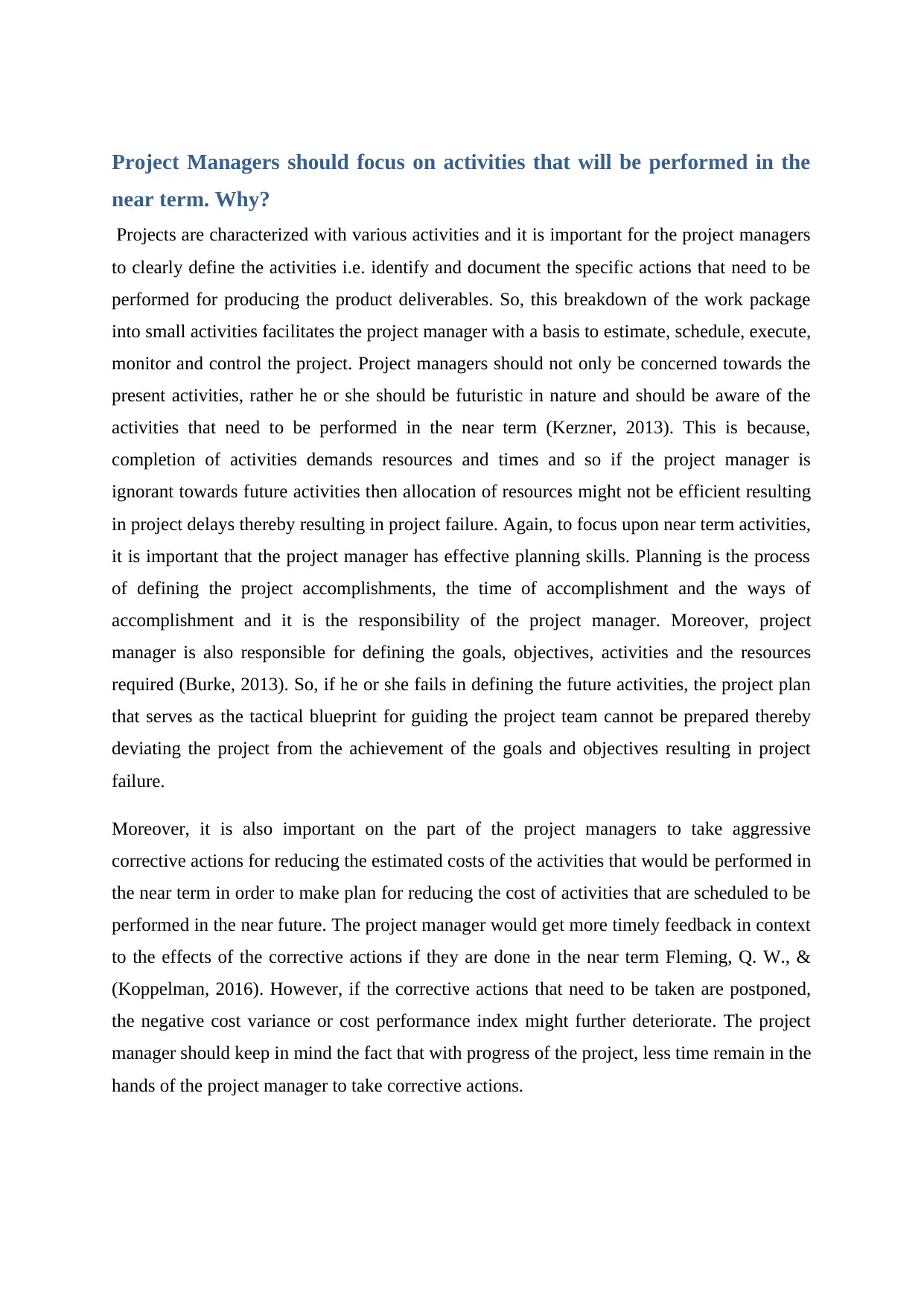
Project Managers should focus on activities that will be performed in the
near term. Why?
Projects are characterized with various activities and it is important for the project managers
to clearly define the activities i.e. identify and document the specific actions that need to be
performed for producing the product deliverables. So, this breakdown of the work package
into small activities facilitates the project manager with a basis to estimate, schedule, execute,
monitor and control the project. Project managers should not only be concerned towards the
present activities, rather he or she should be futuristic in nature and should be aware of the
activities that need to be performed in the near term (Kerzner, 2013). This is because,
completion of activities demands resources and times and so if the project manager is
ignorant towards future activities then allocation of resources might not be efficient resulting
in project delays thereby resulting in project failure. Again, to focus upon near term activities,
it is important that the project manager has effective planning skills. Planning is the process
of defining the project accomplishments, the time of accomplishment and the ways of
accomplishment and it is the responsibility of the project manager. Moreover, project
manager is also responsible for defining the goals, objectives, activities and the resources
required (Burke, 2013). So, if he or she fails in defining the future activities, the project plan
that serves as the tactical blueprint for guiding the project team cannot be prepared thereby
deviating the project from the achievement of the goals and objectives resulting in project
failure.
Moreover, it is also important on the part of the project managers to take aggressive
corrective actions for reducing the estimated costs of the activities that would be performed in
the near term in order to make plan for reducing the cost of activities that are scheduled to be
performed in the near future. The project manager would get more timely feedback in context
to the effects of the corrective actions if they are done in the near term Fleming, Q. W., &
(Koppelman, 2016). However, if the corrective actions that need to be taken are postponed,
the negative cost variance or cost performance index might further deteriorate. The project
manager should keep in mind the fact that with progress of the project, less time remain in the
hands of the project manager to take corrective actions.
near term. Why?
Projects are characterized with various activities and it is important for the project managers
to clearly define the activities i.e. identify and document the specific actions that need to be
performed for producing the product deliverables. So, this breakdown of the work package
into small activities facilitates the project manager with a basis to estimate, schedule, execute,
monitor and control the project. Project managers should not only be concerned towards the
present activities, rather he or she should be futuristic in nature and should be aware of the
activities that need to be performed in the near term (Kerzner, 2013). This is because,
completion of activities demands resources and times and so if the project manager is
ignorant towards future activities then allocation of resources might not be efficient resulting
in project delays thereby resulting in project failure. Again, to focus upon near term activities,
it is important that the project manager has effective planning skills. Planning is the process
of defining the project accomplishments, the time of accomplishment and the ways of
accomplishment and it is the responsibility of the project manager. Moreover, project
manager is also responsible for defining the goals, objectives, activities and the resources
required (Burke, 2013). So, if he or she fails in defining the future activities, the project plan
that serves as the tactical blueprint for guiding the project team cannot be prepared thereby
deviating the project from the achievement of the goals and objectives resulting in project
failure.
Moreover, it is also important on the part of the project managers to take aggressive
corrective actions for reducing the estimated costs of the activities that would be performed in
the near term in order to make plan for reducing the cost of activities that are scheduled to be
performed in the near future. The project manager would get more timely feedback in context
to the effects of the corrective actions if they are done in the near term Fleming, Q. W., &
(Koppelman, 2016). However, if the corrective actions that need to be taken are postponed,
the negative cost variance or cost performance index might further deteriorate. The project
manager should keep in mind the fact that with progress of the project, less time remain in the
hands of the project manager to take corrective actions.
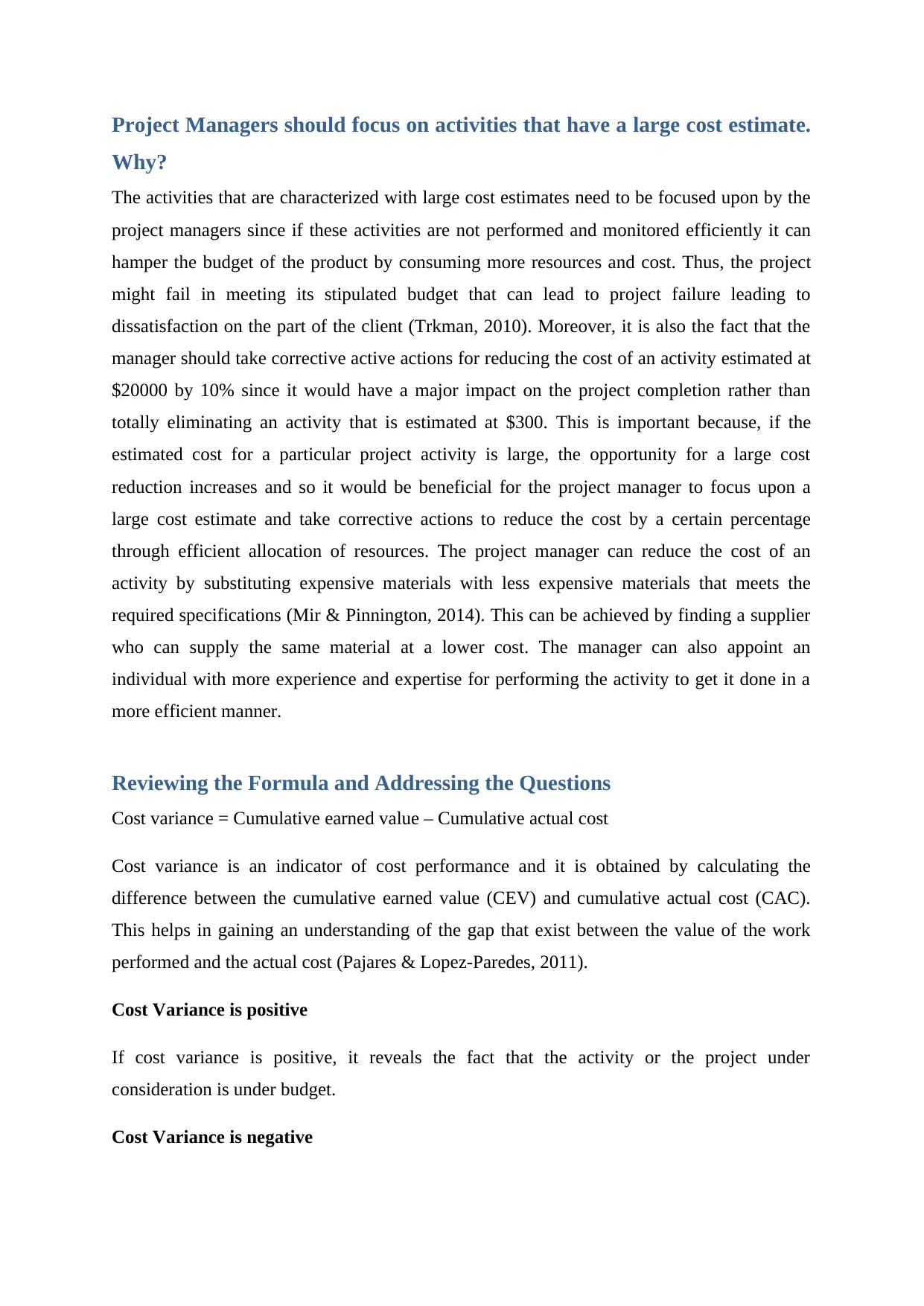
Project Managers should focus on activities that have a large cost estimate.
Why?
The activities that are characterized with large cost estimates need to be focused upon by the
project managers since if these activities are not performed and monitored efficiently it can
hamper the budget of the product by consuming more resources and cost. Thus, the project
might fail in meeting its stipulated budget that can lead to project failure leading to
dissatisfaction on the part of the client (Trkman, 2010). Moreover, it is also the fact that the
manager should take corrective active actions for reducing the cost of an activity estimated at
$20000 by 10% since it would have a major impact on the project completion rather than
totally eliminating an activity that is estimated at $300. This is important because, if the
estimated cost for a particular project activity is large, the opportunity for a large cost
reduction increases and so it would be beneficial for the project manager to focus upon a
large cost estimate and take corrective actions to reduce the cost by a certain percentage
through efficient allocation of resources. The project manager can reduce the cost of an
activity by substituting expensive materials with less expensive materials that meets the
required specifications (Mir & Pinnington, 2014). This can be achieved by finding a supplier
who can supply the same material at a lower cost. The manager can also appoint an
individual with more experience and expertise for performing the activity to get it done in a
more efficient manner.
Reviewing the Formula and Addressing the Questions
Cost variance = Cumulative earned value – Cumulative actual cost
Cost variance is an indicator of cost performance and it is obtained by calculating the
difference between the cumulative earned value (CEV) and cumulative actual cost (CAC).
This helps in gaining an understanding of the gap that exist between the value of the work
performed and the actual cost (Pajares & Lopez-Paredes, 2011).
Cost Variance is positive
If cost variance is positive, it reveals the fact that the activity or the project under
consideration is under budget.
Cost Variance is negative
Why?
The activities that are characterized with large cost estimates need to be focused upon by the
project managers since if these activities are not performed and monitored efficiently it can
hamper the budget of the product by consuming more resources and cost. Thus, the project
might fail in meeting its stipulated budget that can lead to project failure leading to
dissatisfaction on the part of the client (Trkman, 2010). Moreover, it is also the fact that the
manager should take corrective active actions for reducing the cost of an activity estimated at
$20000 by 10% since it would have a major impact on the project completion rather than
totally eliminating an activity that is estimated at $300. This is important because, if the
estimated cost for a particular project activity is large, the opportunity for a large cost
reduction increases and so it would be beneficial for the project manager to focus upon a
large cost estimate and take corrective actions to reduce the cost by a certain percentage
through efficient allocation of resources. The project manager can reduce the cost of an
activity by substituting expensive materials with less expensive materials that meets the
required specifications (Mir & Pinnington, 2014). This can be achieved by finding a supplier
who can supply the same material at a lower cost. The manager can also appoint an
individual with more experience and expertise for performing the activity to get it done in a
more efficient manner.
Reviewing the Formula and Addressing the Questions
Cost variance = Cumulative earned value – Cumulative actual cost
Cost variance is an indicator of cost performance and it is obtained by calculating the
difference between the cumulative earned value (CEV) and cumulative actual cost (CAC).
This helps in gaining an understanding of the gap that exist between the value of the work
performed and the actual cost (Pajares & Lopez-Paredes, 2011).
Cost Variance is positive
If cost variance is positive, it reveals the fact that the activity or the project under
consideration is under budget.
Cost Variance is negative
⊘ This is a preview!⊘
Do you want full access?
Subscribe today to unlock all pages.

Trusted by 1+ million students worldwide
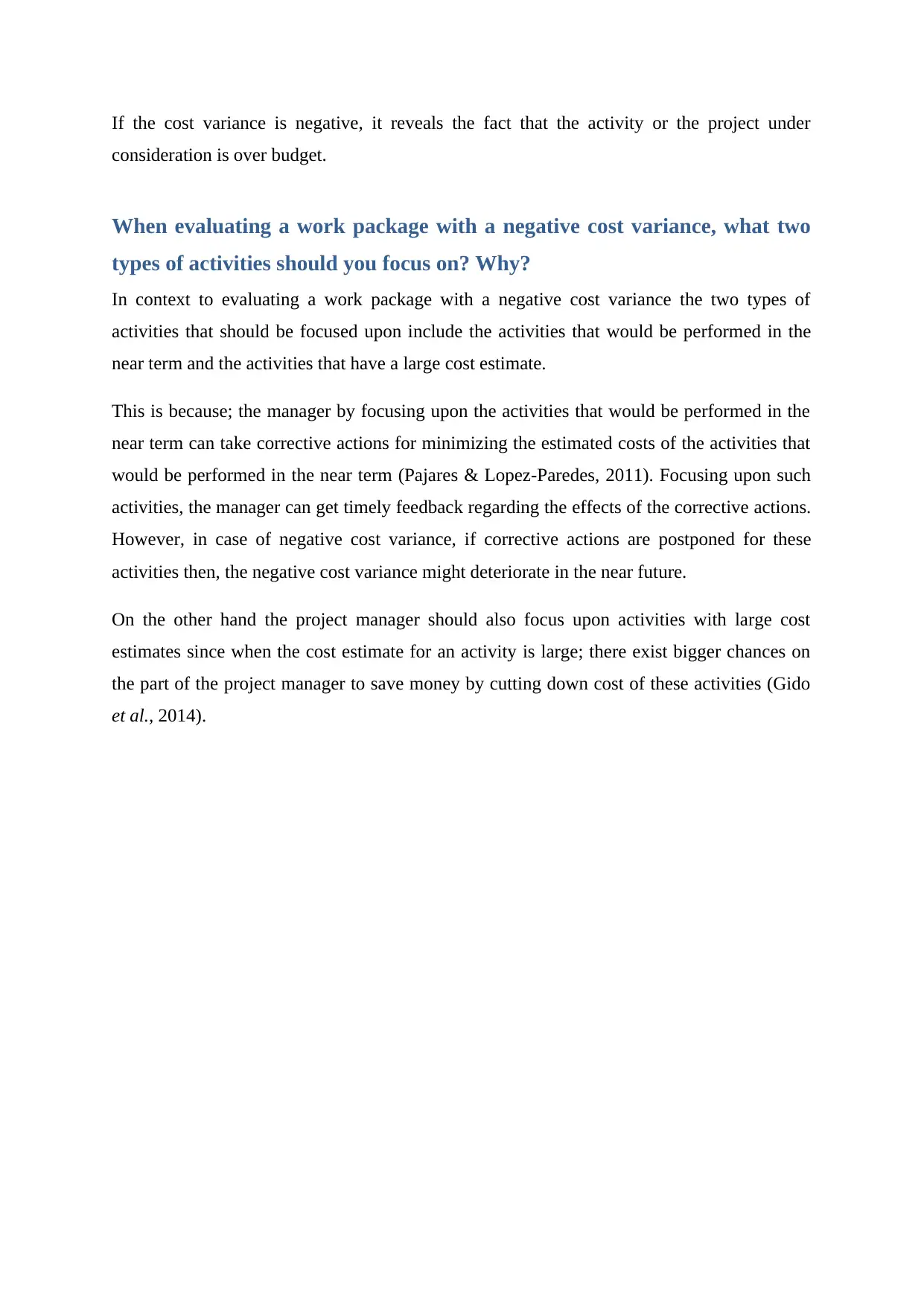
If the cost variance is negative, it reveals the fact that the activity or the project under
consideration is over budget.
When evaluating a work package with a negative cost variance, what two
types of activities should you focus on? Why?
In context to evaluating a work package with a negative cost variance the two types of
activities that should be focused upon include the activities that would be performed in the
near term and the activities that have a large cost estimate.
This is because; the manager by focusing upon the activities that would be performed in the
near term can take corrective actions for minimizing the estimated costs of the activities that
would be performed in the near term (Pajares & Lopez-Paredes, 2011). Focusing upon such
activities, the manager can get timely feedback regarding the effects of the corrective actions.
However, in case of negative cost variance, if corrective actions are postponed for these
activities then, the negative cost variance might deteriorate in the near future.
On the other hand the project manager should also focus upon activities with large cost
estimates since when the cost estimate for an activity is large; there exist bigger chances on
the part of the project manager to save money by cutting down cost of these activities (Gido
et al., 2014).
consideration is over budget.
When evaluating a work package with a negative cost variance, what two
types of activities should you focus on? Why?
In context to evaluating a work package with a negative cost variance the two types of
activities that should be focused upon include the activities that would be performed in the
near term and the activities that have a large cost estimate.
This is because; the manager by focusing upon the activities that would be performed in the
near term can take corrective actions for minimizing the estimated costs of the activities that
would be performed in the near term (Pajares & Lopez-Paredes, 2011). Focusing upon such
activities, the manager can get timely feedback regarding the effects of the corrective actions.
However, in case of negative cost variance, if corrective actions are postponed for these
activities then, the negative cost variance might deteriorate in the near future.
On the other hand the project manager should also focus upon activities with large cost
estimates since when the cost estimate for an activity is large; there exist bigger chances on
the part of the project manager to save money by cutting down cost of these activities (Gido
et al., 2014).
Paraphrase This Document
Need a fresh take? Get an instant paraphrase of this document with our AI Paraphraser
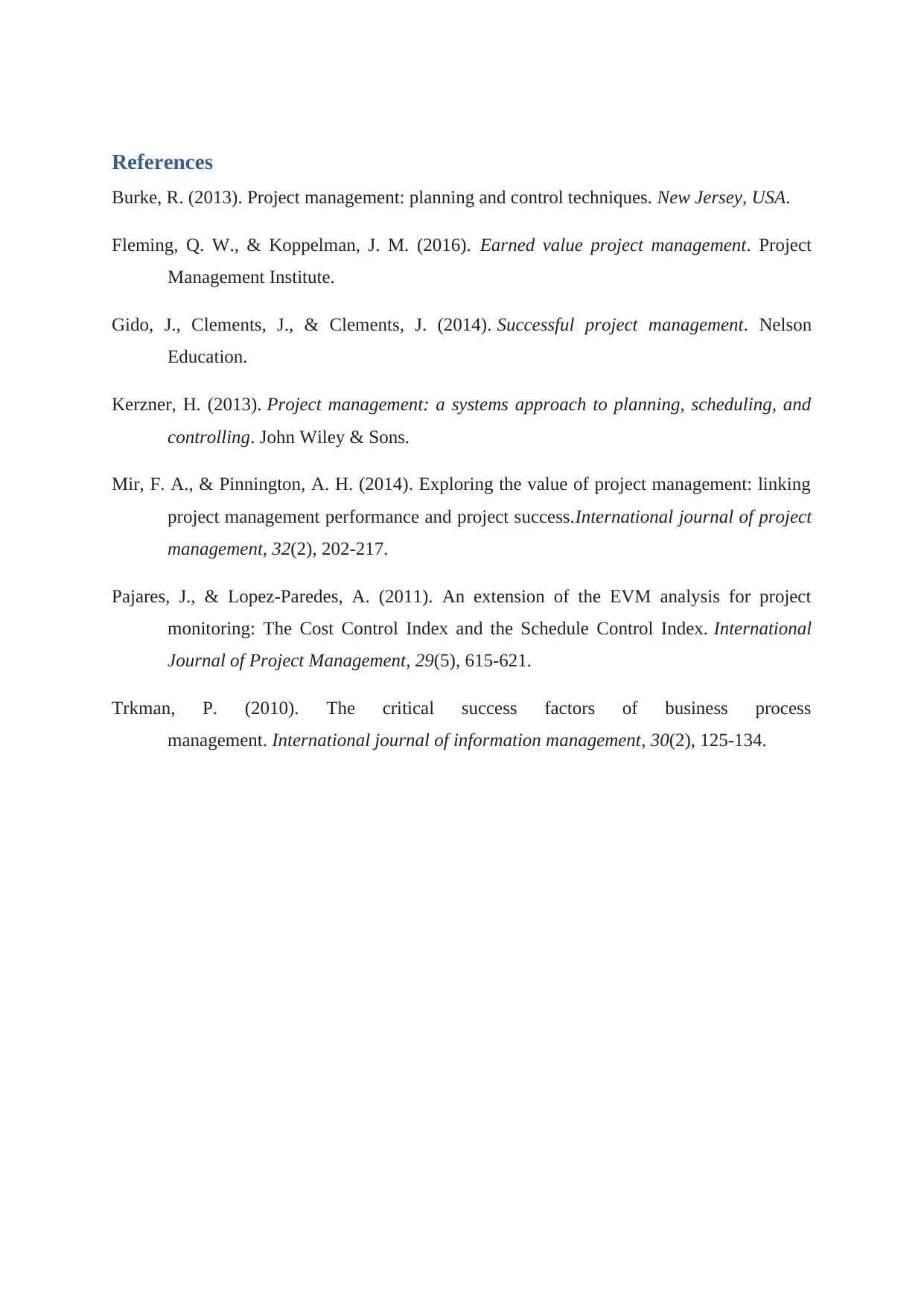
References
Burke, R. (2013). Project management: planning and control techniques. New Jersey, USA.
Fleming, Q. W., & Koppelman, J. M. (2016). Earned value project management. Project
Management Institute.
Gido, J., Clements, J., & Clements, J. (2014). Successful project management. Nelson
Education.
Kerzner, H. (2013). Project management: a systems approach to planning, scheduling, and
controlling. John Wiley & Sons.
Mir, F. A., & Pinnington, A. H. (2014). Exploring the value of project management: linking
project management performance and project success.International journal of project
management, 32(2), 202-217.
Pajares, J., & Lopez-Paredes, A. (2011). An extension of the EVM analysis for project
monitoring: The Cost Control Index and the Schedule Control Index. International
Journal of Project Management, 29(5), 615-621.
Trkman, P. (2010). The critical success factors of business process
management. International journal of information management, 30(2), 125-134.
Burke, R. (2013). Project management: planning and control techniques. New Jersey, USA.
Fleming, Q. W., & Koppelman, J. M. (2016). Earned value project management. Project
Management Institute.
Gido, J., Clements, J., & Clements, J. (2014). Successful project management. Nelson
Education.
Kerzner, H. (2013). Project management: a systems approach to planning, scheduling, and
controlling. John Wiley & Sons.
Mir, F. A., & Pinnington, A. H. (2014). Exploring the value of project management: linking
project management performance and project success.International journal of project
management, 32(2), 202-217.
Pajares, J., & Lopez-Paredes, A. (2011). An extension of the EVM analysis for project
monitoring: The Cost Control Index and the Schedule Control Index. International
Journal of Project Management, 29(5), 615-621.
Trkman, P. (2010). The critical success factors of business process
management. International journal of information management, 30(2), 125-134.
1 out of 5
Related Documents
Your All-in-One AI-Powered Toolkit for Academic Success.
+13062052269
info@desklib.com
Available 24*7 on WhatsApp / Email
![[object Object]](/_next/static/media/star-bottom.7253800d.svg)
Unlock your academic potential
Copyright © 2020–2025 A2Z Services. All Rights Reserved. Developed and managed by ZUCOL.





![Project Scheduling and Time Management Report - [Course Name]](/_next/image/?url=https%3A%2F%2Fdesklib.com%2Fmedia%2Fimages%2Fvl%2F08ca5540273c481b91219691dd50a94c.jpg&w=256&q=75)